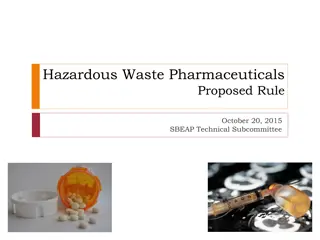Waste Collection Systems Overview and Best Practices
Waste collection systems can be classified as manual or mechanical based on the type of collection vehicle used. Residential waste loading methods include direct lifting, rolling of containers, and use of lifts. Commercial and industrial services typically utilize large mobile or stationary containers with compactors. To establish an effective collection system, factors such as trained labor, suitable vehicles, equipment, planning routes, and public satisfaction must be considered. Hauled Container System (HCS) and Stationary Container System (SCS) are two common collection approaches, each with its own advantages. Analysis of truck capacity, loading weight, and manpower requirements is crucial for optimizing waste collection operations.
Download Presentation

Please find below an Image/Link to download the presentation.
The content on the website is provided AS IS for your information and personal use only. It may not be sold, licensed, or shared on other websites without obtaining consent from the author.If you encounter any issues during the download, it is possible that the publisher has removed the file from their server.
You are allowed to download the files provided on this website for personal or commercial use, subject to the condition that they are used lawfully. All files are the property of their respective owners.
The content on the website is provided AS IS for your information and personal use only. It may not be sold, licensed, or shared on other websites without obtaining consent from the author.
E N D
Presentation Transcript
Methods of loading the collection vehicle: May be classified as either Manual or mechanical depending on the collection vehicle: A- loading of residential waste include: - The direct lifting and carry of container and dumping into vehicle. - The rolling of loaded containers on their rim (when they are heavy). - The use of small lifts for rolling the container to the collection vehicle. - The use of large container or drop clothes in which wastes from small container are emptied before being carried to collection vehicles. B- commercial and industrial service : Also for medium and high rise building. - Usually they are use large mobile or stationary container with large compactor. The containers usually provided with rollers. They are rolled manually to the collection vehicle and emptied mechanically and return then to their storage location. Collection System: - Collection procedure require to satisfy: 1. Demand of public approach. 2. Municipal economy. 3. Public health and environmental requirement. Collection system to be well organized require. 1. Selection of trained labour. 1
2. Purchasing suitable vehicle, equipment. 3.Planning collection route. 4.Public attitude satisfaction. Collection system types: can be classified 1.The mode of operation which mostly related to the storage container types. 2. The equipment used. 3. The type of wastes collected. collection systems according to the mode of operation. 1. Hauled Container System. HCS 2. Stationary Container System. SCS 1.Hauled container system (HCS) - Can be defined as the system in which containers used for the storage of waste are hauled to the disposal site, emptied and returned to either there original location or some other location. For this the container usually of the roll-off large containers located in areas of high generation rates. 2.Stationary container system (SCS): Containers used for the storage of S.W ( usually of small size) remain at the point of generation except for occasional short trip to the vehicle (collection vehicle). 2
Comparison between HCS, SCS HCS: Used and suitable for: 1.Removal of waste from sources of high G.R. 2.Eliminate handling time of many small container. 3.Eliminate unsightly accumulation associate with the use of a great no. of small container. 4.Flexibility, possibility of using container of different sizes and shapes for all types of wastes. 5.Require only one truck and driver to accomplish collection cycle. 6.Container size is of great economic importance compaction add economic advantages and unloading facilities. SCS: 1.Used for all type of wastes. 2.It vary according to type and quantity of wastes to be handled. 3.It vary according to No. of generation points and the loading process of vehicles. 4.Require more crews so it is more expensive. Generally, collection, equipts for HCS and SCS differ in size and capacity, and characteristics, the following, considered, must be classified. 1.Suitable cover with provision for easy loading and un loading 2.Water tight constant preferably metallic to prevent leakage and spill and easily cleaner. 3
3. Truck capacity depend on waste collection, loading weight, man power requirement. Analysis of collection system - To establish vehicles and labour requires for various collection system and methods. - The unit time required to perform each task in the system must be determined. collection activities (tasks) can be separated into unit operations as follow: 1. Pick Up: definition for SCS and HCS a.SCS: Time spent loading the collection vehicles. b.HCS: Time spent driving to the next container after an empty container has been deposits and the time spent picking up the loaded container and the time requirement to redeposit the container after its contents has been emptied. 2. Haul (H) a.SCS: time required to reach the disposal site starting after the vehicle is filled pluse time after leaving the disposal site until arrival at the location of the next collection route. b. HCS: time required to reach the disposal site starting after loading the container on truck time after leaving the disposal site to the location where the empty container is to be redeposit. 3. At site for HCS and SCS: time spent the disposal site waiting and un loading. 4
4. Off route: for both system include all time spent on activities that are non productive , such as: - Checking in and out at beginning and end of day work. - Time spent to the first pick up point. - Time spent due to congestion. - Time spent an equipt. repair and Maintenance. - Time spent for lunch in excess of the started period. 5
1- SCS 6
2- HCS 7























